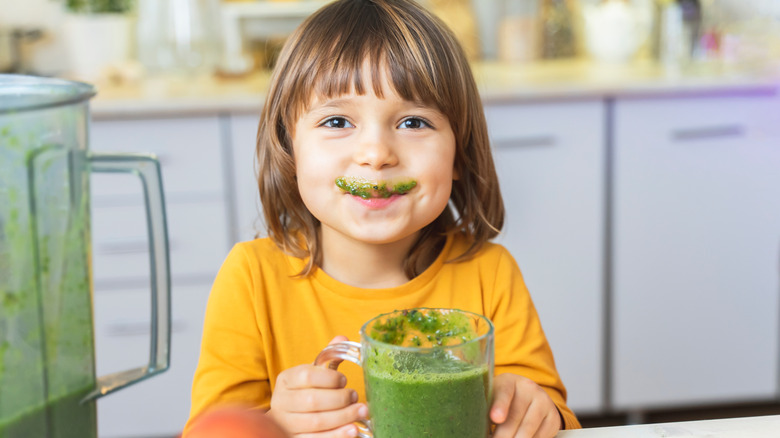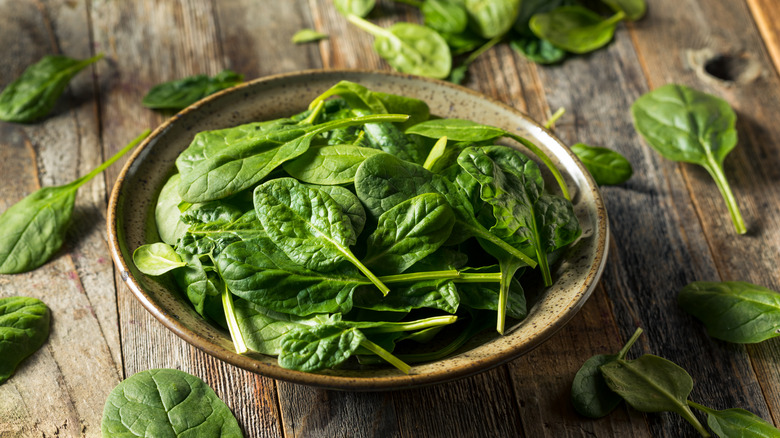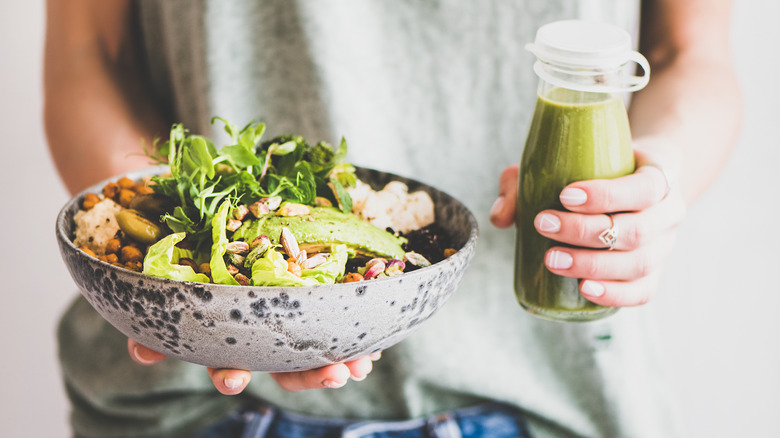Raw Spinach Vs Cooked Spinach: Which One Is Better For You?
We all know Popeye's favorite snack, spinach. The nutrient content in this leafy green is so staggering, that experts at Livestrong dubbed it a "superfood." Maybe you've noshed on it raw, cascaded with dressing, or possibly you've ordered a steamy stir-fry for takeout. Either way, it's appetizing. Given its powerful qualities, does it provide the most nutrients when it's cooked or just simply raw?
First let's break down the nutritional data on this green leaf. According to Healthline, 3.5 ounces (about a half cup) of spinach holds 2.9 grams of protein, 23 calories, and is made up of 91% water. It's safe to say enjoying this leafy green is never a bad idea. The U.S. Department of Agriculture (USDA) recommends up to three cups of veggies per day for women between 18 to 60 years old. On the other hand, men above 18 years of age need around four cups, decreasing to about 3½ cups after the age of 60.
So, just how should you eat spinach for maximum nutrition?
The risks and benefits of raw spinach
Raw spinach doesn't contain much fat or carbohydrates, according to Livestrong. The high fiber content adds bulk to your bowels. In fact, this natural colon cleanser inhibits the development of conditions like colon cancer (Medical News Today). Spinach has all nine amino acids, per Livestrong. So what's made up of over 90% water and good for your eyes? Popeye's secret weapon. After all, spinach contains carotenoids, which can eventually be transformed into vitamin A, according to Healthline. In a 1995 study, researchers even encouraged the intake of foods with high carotenoids because it could reduce the risk of macular degeneration.
However, there is one risk to eating spinach raw: oxalates (via Healthline). These are waste products from metabolized vitamin C (via Washington College). According to SFGate, oxalates create the round chunky mineral deposits known as kidney stones. A balanced consumption of oxalates is fine, but if you've previously had kidney stones, maybe it's best to pass on the spinach salad. To prevent overexposure, Washington College recommends combining raw spinach with high-calcium foods to counteract the oxalates. Perhaps cooked spinach could be better than eating it raw?
The risks and benefits of cooked spinach
Although some experts scrutinize processed foods, processing doesn't seem to be all bad. In this case, you're removing pesky oxalate residue after blanching your spinach and discarding the liquid (via Washington College).
In 2016, an overview published by the International Journal of Life Sciences and Review highlighted the abundance of iron, flavonoids, and folic acid in cooked spinach. The flavonoids, along with other components, give this veggie antioxidative power to fight free radicals. Boiling the leaves makes the nutrients more bioavailable (via Vegetarian Times). When it's cooked, spinach also stimulates childhood growth, reduces fatigue, and prevents cancer (via International Journal of Life Sciences and Review).
Once boiled, spinach loses about 75% of its vitamin C content from fresh and frozen spinach, according to a 2012 study. You could get that and more by simply tossing it in the blender for a smoothie. In this case, researchers measured the folate, vitamin C, and lutein found in raw spinach versus cooked. The results undeniably showed that the folate in fresh spinach was cut down by 50% after cooking. Lutein won't give you muscles like Popeye, but it will help shield your eyes from harmful light waves (WebMD). The study found that after cooking spinach, lutein levels remained nearly the same, while vitamin C levels plummeted. Overall, steaming the spinach proved to be the most nutritious cooking method, while boiling removed most of the benefits.
Which is healthier?
Spinach is a good source of iron, whether cooked or raw (via Livestrong). To absorb the highest nutrient content, enjoy your spinach raw. If you prefer to cook it, the best method is to steam it lightly (per the 2012 study). Dipping your spinach bundle in hot water allows the oxalates to boil off, making it safer to eat for people with a high kidney stone risk. Cook it mindfully, and remember that overboiling spinach makes the nutrient value dip extremely low.
When it comes whether you should eat raw spinach or cooked spinach, the conclusion is a toss-up. Ultimately your preference may decide what's truly best. Whether blending it in a shake or filling a breakfast quiche, spinach will help you meet multiple nutritional needs. You can simply incorporate spinach into your diet however you'd like.




